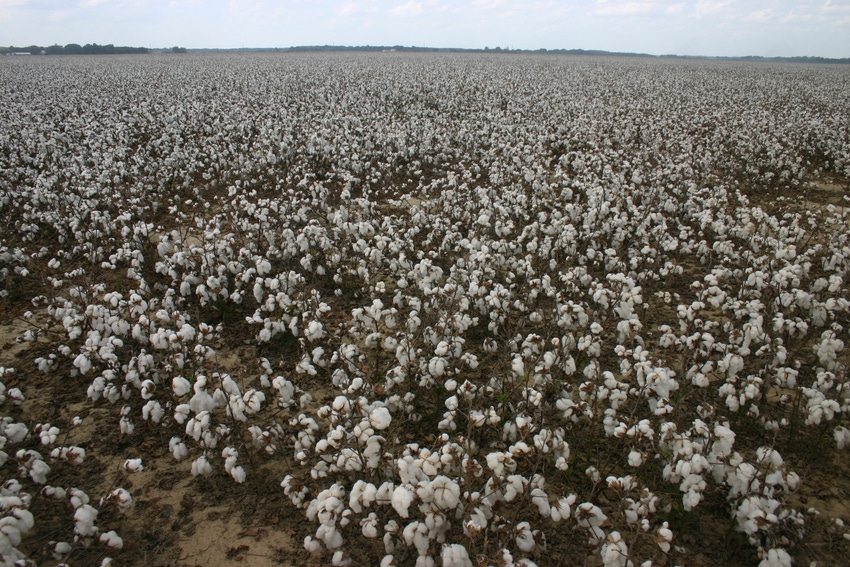
Water use by agriculture is drawing increasing scrutiny from state and federal agencies.
“If you look at where the world’s population is predicted to go by 2050, and look at the water use that population will require, (such agencies) are going to start looking hard at irrigation,” said Darrin Dodds, Mississippi State University Extension cotton specialist, at the recent ACP-Cotton Foundation joint meeting in New Orleans. “There has been a lot of research done in the West where there’s a lot drier environment. But (Mid-South and Southeast) aquifers are coming down and there are a lot of potential restrictions coming down the line.”
In anticipation, Southern researchers are looking at moisture sensors. “When it comes to row crops, cotton isn’t the heaviest user of water. Corn tends to take more water than cotton. Still, there’s room for improvement.
Dodds pointed to work done by Jason Krutz, Mississippi State University Extension irrigation specialist. “He’s as good as they come.” Krutz’s field work in corn and soybeans has shown “irrigation can be cut almost in half and yields maintained. Think about how much money you’re saving by cutting corn irrigations from six to three. Those savings aren’t just in diesel and electricity but there are environmental benefits.
“If we can show that we’re saving water by implementing some of these irrigation methods, it does nothing but look good for cotton.”
A lot of time it’s hard to translate small plot work into your farms. However, “with this irrigation work, we’ve gone straight to the farm.” Dodds says the Bush family, who farm outside Greenwood, Miss., “is great and very easy to work with. We went to them and said, ‘We want to do some irrigation work with y’all. We want to use moisture sensors to help schedule irrigations a bit more scientifically.’
“So, we basically broke a field into four blocks. The first block they watered however they wanted. That block was irrigated three times starting June 25. A (second) block was watered three times staring June 30. The (third) block was irrigated twice starting July 10. The (fourth) block was watered twice starting July 5.”
Which block yielded the highest? The third block, “which was watered the latest and only twice. When Chris Bush got off the cotton picker and saw the numbers he hardly believed it. But we’ve done this two or three years in a row, now.
“They were probably over-irrigating a bit. Their intervals were probably a little tight, the soil was a little saturated and the plants weren’t growing off as well. They’ve since adopted many of the sensors, which can provide data that can be accessed in your office.”
The sensors aren’t cheap, warned Dodds. “But if you can save an irrigation, or two, the investment in a few of them can be worth it. They might also help you avoid some of the potential regulations that are coming.”
Corn shift
When corn really began moving into the Mid-South, some looked at the shift as unfavorable towards cotton. In contrast, Dodds “ tends to see the glass as half-full. Researchers at (the research station in Stoneville, Mississippi) recently shared some data. Starting in 2000 through 2011, (they looked at a) corn/cotton rotation versus a straight cotton monoculture. … Just about every year there was a sizable percent yield increase where there was a corn/cotton rotation.
“The two years we didn’t see that – 2004 and 2007 – what happened? In 2004, the Mid-South had 26 days of rain in June. In 2007, it was just the opposite with June and July being very dry. But the average response over 11 years for a corn/cotton rotation is almost a 17 percent yield increase.
“One point about corn is we’ve learned the hard way that when we mix corn and cotton, plant bugs tend to flock out of corn into the cotton. There’s a big edge effect 36 to 40 rows out of corn. We’ve learned to block our corn and cotton together as best we can.”
Thrips, pigweed
Dodds said resistance issues with seed treatments and thrips will “change the way we think in the Mid-South, Southeast and other areas. We know for a fact there’s thrip resistance to thiamethoxam in the Mid-South. As a whole, Mississippi and other Mid-South states moved away from thiamethoxam seed treatments in 2015.”
That led to producers placing “a lot of pressure on imidacloprid. I’ll tell you imidacloprid in the Mid-South is slipping with respect to thrips. We have assays in the lab right now and straight imidacloprid seed treatments won’t be recommended in Mississippi and, probably, other Mid-South states for thrip control in 2016.
“The problem with that is if you choose to plant a bran of seed that you can’t get a particular seed treatment on. Do you plant a straight fungicide-only seed and keep your sprayer ready? Do you roll the dice on imidacloprid or thiamethoxam?”
As for weed control, “from west Texas all the way to North Carolina, Palmer amaranth is our true nemesis. In battling this thing for the first year or two, we learned there’s no way to get away from residuals. There’s no way to do it. If you try to make a go of it without residuals in cotton, you’re way behind the eight ball.
“The other complicating factor is several weeks ago it came out that the Mid-South is starting to see PPO resistance in Palmer amaranth. I’m sure that will spread like it always has.”
Where does that put producers?
“Glyphosate isn’t working. ALS chemistry is largely ineffective in Palmer populations. Take the PPOs out and that leaves us Liberty. In the Mid-South, we’re driving that Liberty train hard – and at $20 a shot, it isn’t a cheap train to drive. It wouldn’t be a shock if Liberty resistance shows up in the next couple of years.”
About the Author(s)
You May Also Like




